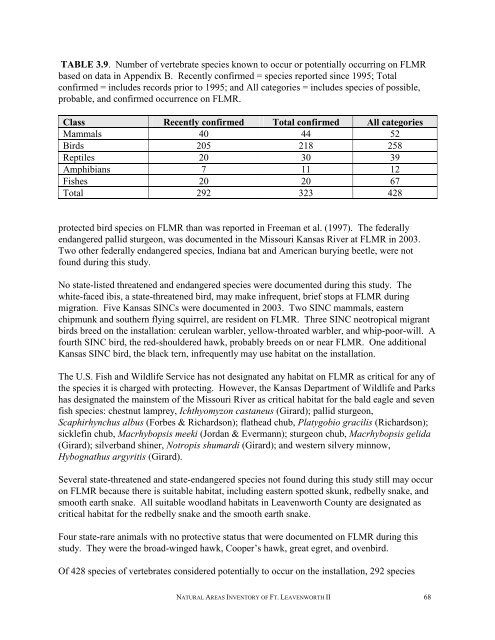A Natural Areas Inventory of the - Kansas Natural Heritage Inventory ...
A Natural Areas Inventory of the - Kansas Natural Heritage Inventory ...
A Natural Areas Inventory of the - Kansas Natural Heritage Inventory ...
Create successful ePaper yourself
Turn your PDF publications into a flip-book with our unique Google optimized e-Paper software.
TABLE 3.9. Number <strong>of</strong> vertebrate species known to occur or potentially occurring on FLMR<br />
based on data in Appendix B. Recently confirmed = species reported since 1995; Total<br />
confirmed = includes records prior to 1995; and All categories = includes species <strong>of</strong> possible,<br />
probable, and confirmed occurrence on FLMR.<br />
Class Recently confirmed Total confirmed All categories<br />
Mammals 40 44 52<br />
Birds 205 218 258<br />
Reptiles 20 30 39<br />
Amphibians 7 11 12<br />
Fishes 20 20 67<br />
Total 292 323 428<br />
protected bird species on FLMR than was reported in Freeman et al. (1997). The federally<br />
endangered pallid sturgeon, was documented in <strong>the</strong> Missouri <strong>Kansas</strong> River at FLMR in 2003.<br />
Two o<strong>the</strong>r federally endangered species, Indiana bat and American burying beetle, were not<br />
found during this study.<br />
No state-listed threatened and endangered species were documented during this study. The<br />
white-faced ibis, a state-threatened bird, may make infrequent, brief stops at FLMR during<br />
migration. Five <strong>Kansas</strong> SINCs were documented in 2003. Two SINC mammals, eastern<br />
chipmunk and sou<strong>the</strong>rn flying squirrel, are resident on FLMR. Three SINC neotropical migrant<br />
birds breed on <strong>the</strong> installation: cerulean warbler, yellow-throated warbler, and whip-poor-will. A<br />
fourth SINC bird, <strong>the</strong> red-shouldered hawk, probably breeds on or near FLMR. One additional<br />
<strong>Kansas</strong> SINC bird, <strong>the</strong> black tern, infrequently may use habitat on <strong>the</strong> installation.<br />
The U.S. Fish and Wildlife Service has not designated any habitat on FLMR as critical for any <strong>of</strong><br />
<strong>the</strong> species it is charged with protecting. However, <strong>the</strong> <strong>Kansas</strong> Department <strong>of</strong> Wildlife and Parks<br />
has designated <strong>the</strong> mainstem <strong>of</strong> <strong>the</strong> Missouri River as critical habitat for <strong>the</strong> bald eagle and seven<br />
fish species: chestnut lamprey, Ichthyomyzon castaneus (Girard); pallid sturgeon,<br />
Scaphirhynchus albus (Forbes & Richardson); fla<strong>the</strong>ad chub, Platygobio gracilis (Richardson);<br />
sicklefin chub, Macrhybopsis meeki (Jordan & Evermann); sturgeon chub, Macrhybopsis gelida<br />
(Girard); silverband shiner, Notropis shumardi (Girard); and western silvery minnow,<br />
Hybognathus argyritis (Girard).<br />
Several state-threatened and state-endangered species not found during this study still may occur<br />
on FLMR because <strong>the</strong>re is suitable habitat, including eastern spotted skunk, redbelly snake, and<br />
smooth earth snake. All suitable woodland habitats in Leavenworth County are designated as<br />
critical habitat for <strong>the</strong> redbelly snake and <strong>the</strong> smooth earth snake.<br />
Four state-rare animals with no protective status that were documented on FLMR during this<br />
study. They were <strong>the</strong> broad-winged hawk, Cooper’s hawk, great egret, and ovenbird.<br />
Of 428 species <strong>of</strong> vertebrates considered potentially to occur on <strong>the</strong> installation, 292 species<br />
NATURAL AREAS INVENTORY OF FT. LEAVENWORTH II 68


